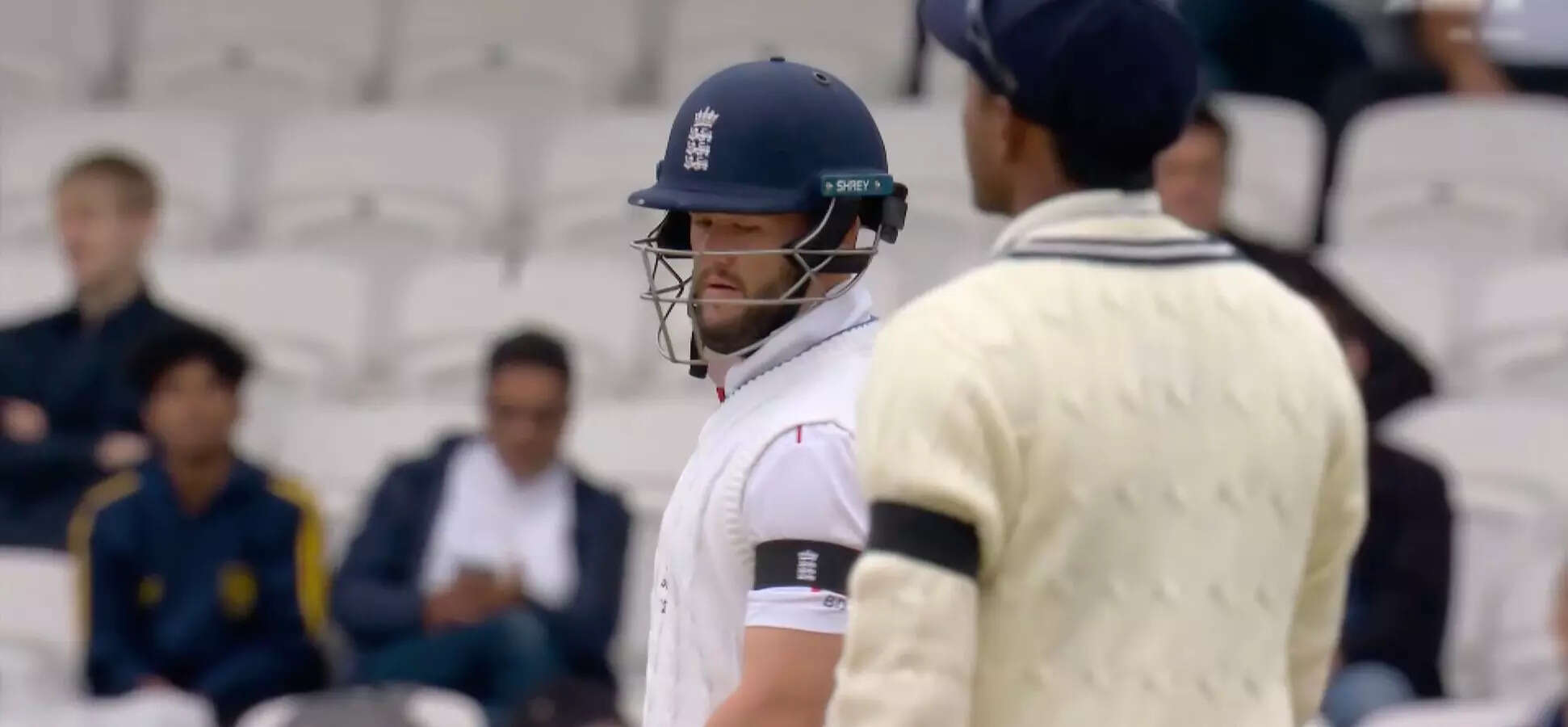ARTICLE AD BOX
TOI TimesPoints
HOW TO EARNMY ACTIVITYFAQs
DAILY CHECK-INS: 0/5 completed
Lifetime
0
Expired
0
Redeemed
0
* TimesPoints expire in 1 year from the day of credit
 India and England players wearing black armbands during the first Test at Headingley, Leeds. (Jiostar)
India and England players wearing black armbands during the first Test at Headingley, Leeds. (Jiostar)India and England players came out for Day 5 of the first Test at Headingley, Leeds, wearing black armbands to honour former India spinner Dilip Doshi, who passed away at 77 on Monday. The former left-arm spinner died following a cardiac arrest in London. The team's observed a minute's silence as well.
LIVE: India vs England 1st Test Day 5
Doshi, despite spending much of his early career in the shadow of the great Bishan Singh Bedi, carved a niche for himself with his unwavering resolve.
Congratulations!
You have successfully cast your vote
Go Beyond The Boundary with our YouTube channel. SUBSCRIBE NOW!
Doshi took 114 Test wickets in 33 matches, including six five-wicket hauls. He also notched 22 wickets in 15 ODIs. Doshi played first-class cricket for Saurashtra, Bengal, Warwickshire and Nottinghamshire.
IND vs ENG 1st Test: KL Rahul’s grit, Rishabh Pant’s fire keep India alive
05:31

The spinner made his Test debut in 1979 after Bedi's retirement and played the last of his 33 games in 1983. He was exceptional at home during the first three Test seasons, completing 100 scalps in just 28 Tests.
The Board of Control for Cricket in India (BCCI) paid homage to the veteran.
"It is with deep sadness that we learn of the passing of Dilip Doshi. He was a true artist of spin bowling, a gentleman both on and off the field, and a dedicated servant of Indian cricket," BCCI President Roger Binny said in statement.
"His impact on the game was immense, and he inspired a generation of cricketers with his skill and dedication. His contribution to Indian cricket will always be remembered.
"We extend our deepest sympathies to his family, friends, and the entire cricketing fraternity during this difficult time."
BCCI secretary Devajit Saikia added "Dilip Doshi was a remarkable cricketer and a great human being. His passion for the game was evident in every ball he bowled. He had a calm demeanour and a fiercely competitive spirit."
Download
The Times of India News App for Latest Sports News
Subscribe
Start Your Daily Mornings with Times of India Newspaper! Order Now
more from times of india Sports
trending videos / Cricket
 IND vs ENG 1st Test: KL Rahul’s grit, Rishabh Pant’s fire keep India alive24 Jun, 2025, 1158 hrs IST05:31
IND vs ENG 1st Test: KL Rahul’s grit, Rishabh Pant’s fire keep India alive24 Jun, 2025, 1158 hrs IST05:31 Josh Tongue press conference: No one is discussing D WORD in dressing room, warning for India?24 Jun, 2025, 0701 hrs IST04:13
Josh Tongue press conference: No one is discussing D WORD in dressing room, warning for India?24 Jun, 2025, 0701 hrs IST04:13 KL Rahul press conference: On his role, being elder brother in team, role clarity and match24 Jun, 2025, 0639 hrs IST14:13
KL Rahul press conference: On his role, being elder brother in team, role clarity and match24 Jun, 2025, 0639 hrs IST14:13 Greenstone Lobo predicts winner of IND vs ENG series | Who Has the Astrological Edge?23 Jun, 2025, 1634 hrs IST09:02
Greenstone Lobo predicts winner of IND vs ENG series | Who Has the Astrological Edge?23 Jun, 2025, 1634 hrs IST09:02 Jasprit Bumrah press conference: Lashes out at critics, dropped catches and no balls23 Jun, 2025, 1050 hrs IST13:26
Jasprit Bumrah press conference: Lashes out at critics, dropped catches and no balls23 Jun, 2025, 1050 hrs IST13:26 Ollie Pope press conference: On Jasprit Bumrah vs Harry Brook, bowling first and more23 Jun, 2025, 1049 hrs IST10:08
Ollie Pope press conference: On Jasprit Bumrah vs Harry Brook, bowling first and more23 Jun, 2025, 1049 hrs IST10:08 India’s Day 3 Test Review: Cloudy skies ahead | Weather twist at Headingley23 Jun, 2025, 0821 hrs IST04:51
India’s Day 3 Test Review: Cloudy skies ahead | Weather twist at Headingley23 Jun, 2025, 0821 hrs IST04:51 Sitanshu Kotak press conference: Big revelation on Shubman Gill22 Jun, 2025, 1552 hrs IST06:35
Sitanshu Kotak press conference: Big revelation on Shubman Gill22 Jun, 2025, 1552 hrs IST06:35 Ben Duckett press conference: What makes Jasprit Bumrah dangerous and more22 Jun, 2025, 1543 hrs IST06:41
Ben Duckett press conference: What makes Jasprit Bumrah dangerous and more22 Jun, 2025, 1543 hrs IST06:41 India lose momentum on Day 2 | England Fight Back at Headingley22 Jun, 2025, 1105 hrs IST04:54
India lose momentum on Day 2 | England Fight Back at Headingley22 Jun, 2025, 1105 hrs IST04:54
Successfully logged in to The Times Of India, Enjoy reading...
Some might call the game of cricket a bat-and-ball game. While the definition may have worked back in the 16th century when it was first played in South-East England, it may receive unfavourable support now. We are now living in the 21 st century, and as things have undergone changes, evolution so to speak, the gentleman’s game too has evolved into becoming something bigger. Though initially stated to be a children’s game by historians, the game has only gone on to become sophisticated and technical, and hence no longer just a game of bat-and-ball. In order to celebrate what we have currently, we ought to honour the past as well. And to take a little walk down the line in regard to the game of cricket, we go to England in the old days. Although cricket now attracts money from all corners, it started its journey as a low-profile sport not pursued by many. Slowly and gradually, the game started getting its recognition. Since then, cricket has also been able to create a junction where different category of people could compete, but most importantly enjoy the same sport. The same movement was triggered in India, when the East India Company introduced to game to the Indian masses. The revered Bombay Quadrangular (held from 1912 to 1936) is one such example. The longest format of the game, Test cricket, has continued to exist even after so many years. In the early 1960s, and once again the story moves to England and its counties, the need for a limited overs format was discussed. The changes were duly made, both domestically and internationally. This meant that the sport would now have a World Cup of its own. When we talk about limited overs format, we are only talking about One day internationals right now since the very popular T20 cricket comes much later in the timeline. The main reason why One Day internationals became a popular choice was because by the end of the game, you surely had just one winner. This paved way for the cricket world cup, which has been played every four years since 1975, with few exceptions in between. During this time, there was a rise in cricket governing bodies. With a new format, there were new teams. The figures were only to increase, with the entry of the shortest format of the game, T20s. Originally introduced by the England and Wales Cricket Board (ECB), T20 games were introduced in 2003 for the inter-county competition. The first men's international T20 match was played between Australia and New Zealand in February 2005 in Auckland. The newest format, the shortest one on the list, provided astonishing moments. One can think about India’s win in the inaugural T20 World Cup in 2007, a campaign which included remarkable moments. The game of cricket, whenever altered to provide something new, always leads to a new option. With T20, cricket’s own club competition system was introduced. Twenty-twenty gave birth to franchise T20 leagues around the world. The Indian Premier League (IPL), one of the flagship T20 leagues, is probably the best example. This gave fans a chance to watch thrillers on the ground more often than usual. Franchise based T20 cricket tournaments also became huge money spinners, with sponsors jumping onto the T20 franchise cricket bandwagon



.png)
.png)
.png)
















 5 hours ago
3
5 hours ago
3




















 English (US) ·
English (US) ·